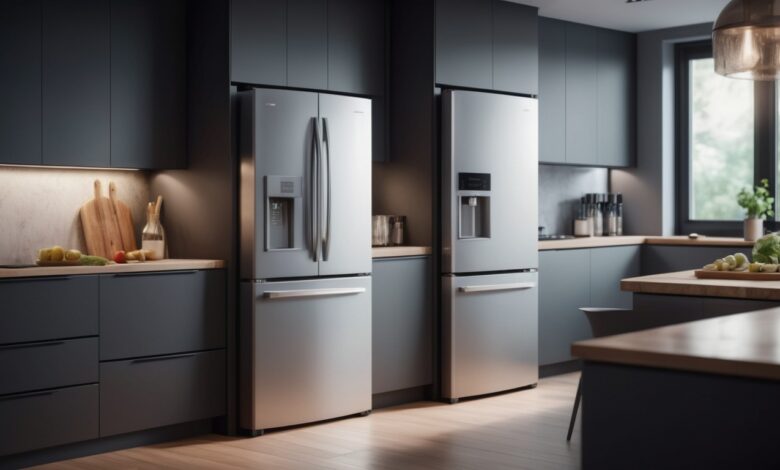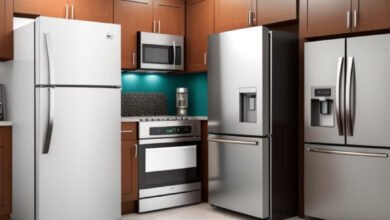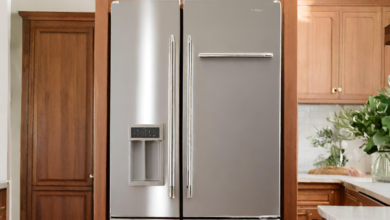How to Increase the Longevity of Your Refrigerator: A Comprehensive Guide

Refrigerators are essential appliances in our homes, working tirelessly to keep our food fresh and our drinks cold. However, like any mechanical device, refrigerators have a limited lifespan. With proper care and maintenance, you can extend the life of your refrigerator, ensuring it remains efficient and functional for many years. In this in-depth guide, we’ll explore a wide range of tips and strategies to help you increase the longevity of your refrigerator.
I. Understanding Refrigerator Lifespan
A. Average Lifespan
The average lifespan of a refrigerator typically ranges from 10 to 20 years, depending on various factors such as usage, brand, model, and maintenance. Understanding the lifespan of your refrigerator allows you to plan for its eventual replacement and take proactive steps to prolong its life.
B. Signs of Aging
It’s essential to recognize the signs of an aging refrigerator to address issues promptly and extend its lifespan. Signs of aging may include increased energy consumption, inconsistent cooling, unusual noises, condensation buildup, or visible wear and tear on components.
II. Proper Installation and Placement
A. Proper Ventilation
Ensure your refrigerator has adequate ventilation by leaving space around it. The condenser coils, located either at the back or underneath the refrigerator, release heat during the cooling process. Proper ventilation prevents overheating and reduces the workload on the compressor, extending its life.
B. Temperature Considerations
Place your refrigerator away from heat sources such as ovens, stoves, and direct sunlight. Excessive heat can cause the compressor to work harder, leading to premature wear and tear. Aim to maintain an ambient temperature around the refrigerator to optimize its performance and longevity.
III. Temperature Regulation and Settings
A. Optimal Refrigerator Temperature
Set your refrigerator’s temperature between 37 to 40 degrees Fahrenheit (or 3 to 4 degrees Celsius) to keep perishable items fresh without overworking the compressor. Avoid setting the temperature too low, as it can lead to unnecessary energy consumption and wear on the appliance.
B. Freezer Temperature Control
Maintain the freezer temperature between 0 to 5 degrees Fahrenheit (-18 to -15 degrees Celsius) to preserve frozen foods effectively. Proper temperature control prevents frost buildup, ensures food safety, and prolongs the life of the freezer components.
IV. Energy Efficiency
A. Energy-Efficient Models
Investing in an energy-efficient refrigerator can significantly impact its longevity. Energy Star-certified models are designed to consume less energy while delivering optimal performance. These refrigerators use advanced technologies to minimize energy consumption and reduce strain on internal components.
B. Scheduled Maintenance
Regular maintenance, including cleaning the condenser coils and checking the door seals, improves the energy efficiency of your refrigerator. Dust and debris accumulation on the coils can impede airflow, causing the compressor to work harder. Cleaning the coils annually or biannually can help maintain peak efficiency.
V. Efficient Use of Storage Space
A. Proper Food Placement
Organize the contents of your refrigerator to maximize airflow and ensure consistent cooling. Avoid overcrowding shelves and blocking air vents, as this can lead to uneven temperatures and strain the compressor. Arrange items strategically to optimize storage space and maintain efficient operation.
B. Regular Defrosting
If your refrigerator has a manual defrost feature, defrost the freezer regularly to prevent ice buildup. Excessive frost accumulation reduces airflow, decreases cooling efficiency, and strains the compressor. Follow the manufacturer’s recommendations for defrosting frequency to maintain optimal performance.
VI. Smart Features and Technology
A. Advanced Temperature Controls
Some refrigerators feature advanced temperature controls that allow you to customize settings for specific food items. Take advantage of these features to optimize cooling and energy efficiency based on your storage needs. Customizable temperature zones help prolong food freshness and reduce energy consumption.
B. Energy-Saving Modes
Many modern refrigerators come with energy-saving modes that adjust temperature settings during periods of low usage. Activate these modes when you’re away from home or during off-peak hours to conserve energy and reduce wear on the compressor. Energy-saving features help extend the life of your refrigerator while lowering utility bills.
VII. Regular Cleaning and Maintenance
A. Interior Cleaning
Regularly clean the interior of your refrigerator to prevent food residue buildup and maintain hygiene. Remove expired or spoiled items, wipe down shelves and drawers, and sanitize surfaces with a mild detergent. A clean interior reduces odors, prevents bacterial growth, and prolongs the life of the appliance.
B. Door Seal Inspection
Inspect the door seals, also known as gaskets, for signs of wear or damage. Damaged seals allow cold air to escape, causing the compressor to run more frequently to maintain temperature settings. Replace worn-out door seals promptly to ensure proper sealing and efficient operation.
C. Condenser Coil Cleaning
Clean the condenser coils regularly to remove dust, dirt, and debris that accumulate over time. Dirty coils restrict airflow, reduce cooling efficiency, and strain the compressor. Use a coil brush or vacuum cleaner to remove debris from the coils and ensure optimal performance.
VIII. Addressing Common Issues
A. Unusual Noises
If your refrigerator is making unusual noises such as buzzing, rattling, or clicking, it may indicate a mechanical issue. Inspect the appliance for loose components, worn-out parts, or debris trapped in the compressor or fan blades. Addressing unusual noises promptly can prevent further damage and extend the life of the refrigerator.
B. Leaks and Water Accumulation
Check for leaks or water accumulation inside the refrigerator, especially around the water dispenser or ice maker. Leaks can damage internal components and lead to mold growth or electrical issues. Regularly inspect and clean the drip pan, drain lines, and water dispenser to prevent water-related damage.
IX. Professional Maintenance and Repairs
A. Scheduled Maintenance
Consider scheduling professional maintenance for your refrigerator at least once a year. Professional technicians can inspect internal components, check refrigerant levels, and identify potential issues before they escalate. Regular maintenance helps keep your refrigerator in optimal condition and extends its lifespan.
B. Prompt Repairs
If you encounter significant issues with your refrigerator, such as cooling problems or mechanical failures, seek professional repairs promptly. Delaying repairs can exacerbate issues, leading to more extensive damage and costly repairs. Contact a qualified technician to diagnose and address refrigerator problems to ensure efficient operation and longevity.
X. Upgrading to a New Model
A. Signs of Irreparable Damage
If your refrigerator exhibits signs of irreparable damage or becomes increasingly inefficient despite maintenance efforts, consider upgrading to a new model. Modern refrigerators are designed with advanced features, improved energy efficiency, and enhanced durability, offering superior performance and longevity.
B. Energy Star-Certified Replacements
When replacing your refrigerator, choose an Energy Star-certified model to maximize energy efficiency and lifespan. Energy Star-rated appliances meet stringent energy efficiency standards and use advanced technologies to minimize environmental impact. Investing in an energy-efficient refrigerator ensures long-term savings on energy bills and reduces your carbon footprint.
XI. Summary
In conclusion, increasing the longevity of your refrigerator requires a combination of proactive maintenance, efficient usage practices, and timely repairs. By understanding the lifespan of your appliance, implementing energy-saving measures, and addressing issues promptly, you can extend the life of your refrigerator and maximize its efficiency.
Ensure your refrigerator remains a reliable and efficient kitchen companion for years to come. Here are additional tips and tricks to further enhance the longevity of your refrigerator:
XII. Tips for Increasing Refrigerator Longevity
A. Avoiding Overstuffing
While it’s important to utilize your refrigerator’s storage space efficiently, overstuffing it can obstruct airflow and strain the compressor. Ensure proper ventilation inside the fridge by avoiding excessive items that may impede the cooling process.
B. Regularly Check and Adjust Door Alignment
Ensure that the refrigerator doors are properly aligned. Misaligned doors can lead to gaps in the seals, causing cold air to escape and warm air to enter. Periodically check and adjust the door alignment to maintain a tight seal and improve overall efficiency.
C. Keep the Refrigerator Level
A well-leveled refrigerator helps ensure proper functioning of the compressor and prevents strain on internal components. Use a leveling tool to check if your refrigerator is balanced. Adjust the leveling feet as needed to maintain stability and promote optimal performance.
D. Store Hot Foods Properly
Allow hot foods to cool to room temperature before placing them in the refrigerator. Introducing hot items directly into the fridge forces the compressor to work harder to regulate temperatures, potentially affecting its longevity. Optimal temperature regulation is achieved when foods are at room temperature before refrigeration.
E. Use Refrigerator Cleaners
Consider using specialized refrigerator cleaners to clean and deodorize the interior. These cleaners are designed to eliminate odors, remove stains, and maintain a hygienic environment inside the fridge. Follow the manufacturer’s instructions for safe and effective cleaning.
F. Rotate Stored Items
Periodically rotate items in your refrigerator to ensure even cooling and prevent certain areas from becoming overburdened. This practice helps distribute the workload across the appliance, minimizing wear on specific components and extending the overall lifespan.
G. Utilize the Vacation Mode
If your refrigerator has a vacation or power-saving mode, activate it when you’re away for an extended period. This feature adjusts the temperature settings to conserve energy while maintaining a safe storage environment. It’s an effective way to reduce energy consumption during periods of low usage.
H. Install a Surge Protector
Protect your refrigerator from electrical surges by installing a surge protector. Power fluctuations can damage sensitive electronic components, including the compressor. A surge protector acts as a safeguard, preventing potential damage and extending the life of your refrigerator.
I. Monitor and Adjust Thermostat Settings
Regularly monitor the thermostat settings and adjust them as needed based on seasonal changes. During colder months, you may be able to slightly increase the temperature settings without compromising food safety. Adjusting settings helps reduce the workload on the compressor and contributes to energy efficiency.
J. Consider Climate Control Features
If you live in a region with high humidity or temperature fluctuations, consider refrigerators with climate control features. These features help the appliance adapt to environmental conditions, optimizing performance and enhancing the longevity of internal components.
K. Keep the Exterior Clean
In addition to cleaning the interior, regularly clean the exterior of your refrigerator. Wipe down the surfaces, including handles and control panels, to prevent the accumulation of dirt and grime. A clean exterior not only enhances the aesthetics but also promotes proper airflow around the appliance.
XIII. Innovative Technologies for Extended Lifespan
A. Inverter Compressors
Consider refrigerators equipped with inverter compressors. Unlike traditional compressors that operate at a fixed speed, inverter compressors adjust their speed based on cooling demand. This technology reduces energy consumption, minimizes wear and tear, and contributes to a longer lifespan.
B. Dual Evaporators
Refrigerators with dual evaporators have separate cooling systems for the refrigerator and freezer compartments. This prevents the transfer of odors between the two sections and allows for more precise temperature control. Dual evaporators contribute to optimal freshness and can extend the life of your refrigerator.
C. Vacuum Insulation Panels
Some advanced refrigerators feature vacuum insulation panels, which provide superior insulation compared to traditional foam insulation. Improved insulation helps the appliance maintain consistent temperatures with less energy consumption, contributing to overall longevity.
XIV. Conclusion
By incorporating these additional tips and taking advantage of innovative technologies, you can significantly increase the longevity of your refrigerator. Proactive maintenance, efficient usage practices, and the adoption of new technologies work in tandem to ensure that your appliance remains a durable and reliable asset in your kitchen for many years. Remember, a well-maintained refrigerator not only saves you money on energy bills but also minimizes the environmental impact of appliance disposal. Embrace these tips and tricks to maximize the return on your investment and enjoy the extended lifespan of your refrigerator.






